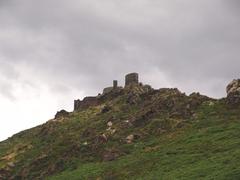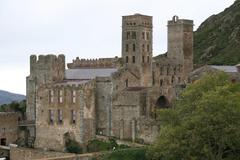Visiting Castrum Visigòtic: Hours, Tickets, and History in Roses, Spain
Publication Date: 31/07/2024
Introduction
Explore the rich history and stunning landscape of Roses, Spain, with a visit to the Castrum Visigòtic, also known as the Visigothic Castle. Situated on the strategic Puig Rom hill, this archaeological marvel dates back to the 6th and 7th centuries AD, providing a fascinating glimpse into the Visigothic Kingdom’s military and architectural prowess. The fortress not only showcases the Visigoths’ efforts to fortify their territories against external threats but also offers panoramic views of the Gulf of Roses and the surrounding landscape. This guide delves into the historical background, architectural features, and practical visitor information, including ticket prices, opening hours, and travel tips, to help you make the most of your trip to this significant historical site (Costa Brava Tourist Guide, Visita Costa Brava).
Table of Contents
- Introduction
- Historical Background
- Visitor Information
- Travel Tips
- Preservation and Conservation
- FAQ
- Conclusion
- References and Further Reading
Historical Background
Origins and Early History
The Castrum Visigòtic, also known as the Visigothic Castle, is a significant historical site located in Roses, Spain. The origins of this fortress date back to the early medieval period, specifically the 6th and 7th centuries AD, during the time of the Visigothic Kingdom. The Visigoths, a Germanic tribe, established their rule over the Iberian Peninsula after the fall of the Western Roman Empire. The construction of the Castrum Visigòtic was part of their efforts to fortify their territories against external threats and internal rebellions.
Architectural Features
The architectural design of the Castrum Visigòtic reflects the typical military engineering of the Visigothic period. The fortress was strategically built on Puig Rom, a hill that offers a commanding view of the surrounding landscape, including the Gulf of Roses. This location was chosen for its defensive advantages, providing visibility over potential maritime and land-based threats.
The structure of the Castrum includes robust stone walls, which were constructed using local materials. These walls were designed to withstand sieges and attacks, featuring narrow slits for archers and elevated platforms for lookouts. The layout of the fortress is relatively simple, focusing on functionality and defense rather than aesthetic appeal.
Historical Significance
The Castrum Visigòtic holds immense historical significance as it represents the Visigothic era’s military and architectural prowess. It is one of the few remaining examples of Visigothic fortifications in the region, providing valuable insights into the period’s defensive strategies and construction techniques. The fortress also serves as a testament to the Visigoths’ influence in the Iberian Peninsula, marking their efforts to establish and maintain control over their territories.
Archaeological Discoveries
Archaeological excavations at the Castrum Visigòtic have unearthed various artifacts that shed light on the daily life and military practices of the Visigoths. These findings include pottery, tools, and weapons, which are now preserved and displayed in local museums. The excavations have also revealed the remains of buildings within the fortress, such as barracks and storage facilities, indicating the site’s role as a military outpost.
One notable discovery is the presence of early Christian symbols and artifacts, suggesting that the fortress may have also served a religious function. This aligns with historical records indicating that the Visigoths, who were initially Arian Christians, later converted to Catholicism, integrating religious practices into their daily lives and military operations.
Visitor Information
Tickets and Visiting Hours
The Castrum Visigòtic is open to the public year-round, with visiting hours typically from 10:00 AM to 6:00 PM. Ticket prices are affordable, with general admission costing around €5. Discounts are available for students, seniors, and groups. It is recommended to check the official website for the most up-to-date information and any special events.
Accessibility
The site is accessible via a short hike from the town of Roses. While the path is generally well-maintained, visitors with mobility issues should be aware that some areas may be challenging to navigate. Comfortable walking shoes are advisable.
Travel Tips
Guided Tours
Enhance your visit with a guided tour to gain deeper insights into the history and significance of the Castrum Visigòtic.
Nearby Attractions
Combine your visit with other nearby historical sites such as the Ciutadella de Roses and the megalithic monuments.
Photography
The hilltop location offers stunning panoramic views, making it an excellent spot for photography enthusiasts.
Local Museums
Explore local museums featuring artifacts from the Castrum and other archaeological sites in the region for a more comprehensive understanding of the Visigothic period.
Preservation and Conservation
Efforts to preserve and conserve the Castrum Visigòtic have been ongoing, with local authorities and heritage organizations working to protect the site from environmental and human-induced damage. These efforts include regular maintenance of the stone walls, controlled access to the site, and educational programs to raise awareness about its historical importance.
The fortress is part of the broader archaeological and cultural heritage of Roses, which includes other significant sites such as the Ciutadella de Roses and the megalithic monuments in the area. Together, these sites form a comprehensive historical narrative of the region, from prehistoric times through the medieval period.
FAQ
What are the visiting hours for Castrum Visigòtic? Castrum Visigòtic is typically open from 10:00 AM to 6:00 PM, but it’s best to check the official website for the most current information.
How much are tickets to Castrum Visigòtic? General admission is around €5, with discounts available for students, seniors, and groups.
Is Castrum Visigòtic accessible for people with mobility issues? The site is accessible via a short hike, but some areas may be challenging for those with mobility issues.
Conclusion
The Castrum Visigòtic in Roses, Spain, is a remarkable historical site that offers a glimpse into the Visigothic era’s military and architectural achievements. Its strategic location, robust construction, and archaeological significance make it a valuable part of the region’s cultural heritage. Preservation efforts ensure that future generations can continue to explore and learn from this important historical landmark.
For more information, you can visit the Costa Brava Tourist Guide and Visita Costa Brava. Stay updated on the latest information by following us on social media and downloading our mobile app, Audiala.
References and Further Reading
- Costa Brava Tourist Guide, 2023, https://costabravatouristguide.com/143-roses-costa-brava
- Visita Costa Brava, 2023, https://www.visitacostabrava.com/en/roses/routes/roses-megalithic-route
- Naturalocal, 2023, https://naturalocal.net/en/routes-trekking-catalunya/routes-trekking-girona/routes-trekking-roses/walk-castrum-visigothic
- ICAC, 2023, https://icac.cat/en/difusio/activitats-dels-investigadors/activitat/new-data-on-the-puig-rom-visigothic-castrum-roses-alt-emporda/
- Roses Cultura, 2023, https://www.rosescultura.cat/ca/castrum-visigotic.html
- Roses in Costa Brava, 2023, https://rosesincostabrava.com/en/vive-la-cultura-en-roses-iv-el-poblado-visigodo-del-puig-rom/
- Visit Costa Brava, 2023, https://www.visitacostabrava.com/en/roses/what-to-visit/retreats/visigothic-castrum
- Empordà Turisme, 2023, https://empordaturisme.com/en/blog/what-to-see-in-roses-in-2-days-complete-guide/



